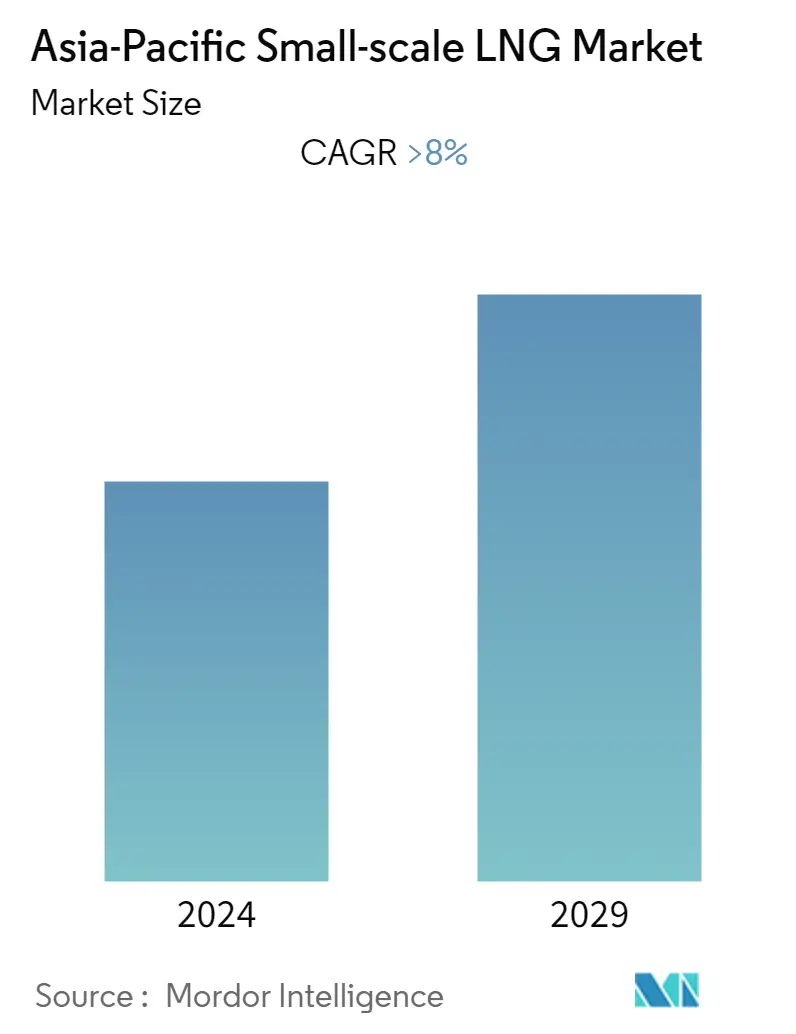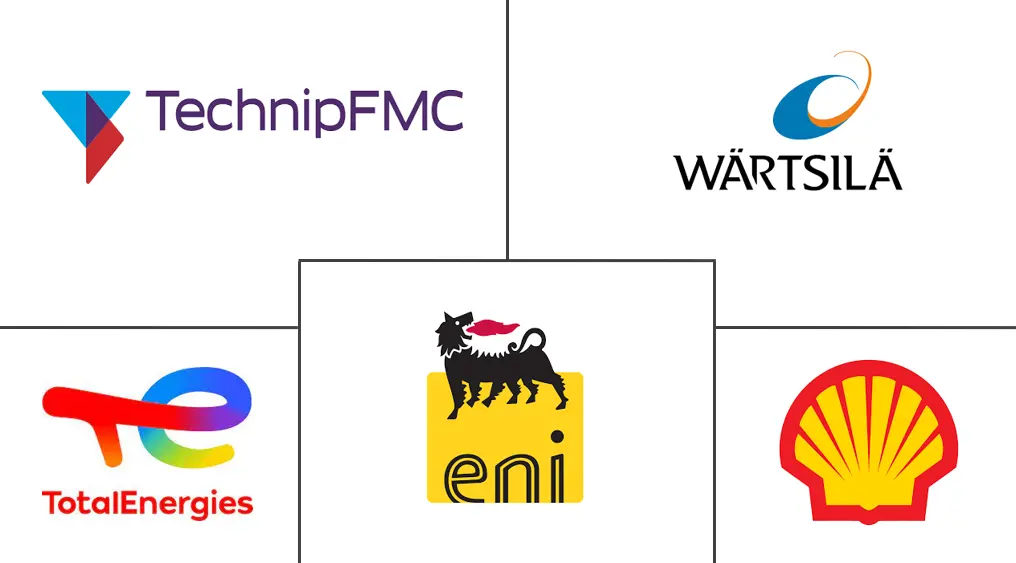Market Size of Asia-Pacific Small-scale LNG Industry

| Study Period | 2020 - 2029 |
| Base Year For Estimation | 2023 |
| Forecast Data Period | 2024 - 2029 |
| Historical Data Period | 2020 - 2022 |
| CAGR | > 8.00 % |
| Market Concentration | Medium |
Major Players
*Disclaimer: Major Players sorted in no particular order |
APAC Small-scale LNG Market Analysis
The Asia-Pacific small-scale LNG market is expected to register a CAGR of over 8% during the forecast period.
The market was negatively impacted by the COVID-19 pandemic in 2020. Presently, the market has reached pre-pandemic levels.
- Over the medium term, factors such as increasing demand for LNG in bunkering, road transportation, and off-grid power are expected to drive the Asia-Pacific small-scale LNG market during the forecast period.
- On the other hand, factors such as the high operation cost of small-scale LNG, high CAPEX requirements, and a long payback period of more than 12 years are expected to hinder the market's growth.
- Nevertheless, developing cost-efficient small-scale LNG infrastructure is expected to provide significant opportunities for small-scale LNG technology providers and transporters.
- China dominates the market and is also likely to witness the highest CAGR during the forecast period. This growth is attributed to the increased demand for LNG and government initiatives to develop LNG-related infrastructure.
APAC Small-scale LNG Industry Segmentation
Small-scale LNG (SSLNG) refers to the liquefaction, regasification, and import terminals at plants with a capacity of less than 1 MTPA and with applications in power generation, transportation, industrial feedstock, etc. The Asia-Pacific small-scale LNG market is segmented by type, mode of supply, application, and geography. By type, the market is segmented into liquefaction terminals and regasification terminals. By mode of supply, the market is segmented into trucks, transshipment and bunkering, and pipeline and rail. By application, the market is segmented into transportation, industrial feedstock, power generation, and other applications. By geography, it is segmented into China, India, Japan, Singapore, and the Rest of Asia-Pacific). For each segment, the market sizing and forecasts have been done based on revenue (USD billion).
| By Type | |
| Liquefaction Terminal | |
| Regasification Terminal |
| By Mode of Supply | |
| Truck | |
| Transshipment and Bunkering | |
| Pipeline and Rail |
| By Application | |
| Transportation | |
| Industrial Feedstock | |
| Power Generation | |
| Other Applications |
| By Geography | |
| China | |
| India | |
| Japan | |
| Singapore | |
| Rest of Asia-Pacific |
Asia-Pacific Small-scale LNG Market Size Summary
The Asia-Pacific small-scale LNG market is poised for significant growth, driven by increasing demand in sectors such as bunkering, road transportation, and off-grid power. Despite challenges like high operational costs and substantial capital expenditure requirements, the development of cost-efficient infrastructure presents substantial opportunities for technology providers and transporters. China stands out as a dominant player in this market, with government initiatives and rising LNG demand fueling its expansion. The country is expected to experience the highest growth rate in the region, supported by its strategic investments in LNG import capacity and infrastructure development.
Small-scale liquefaction terminals, with production capacities under 0.5 million tons per year, are crucial for supplying areas lacking traditional infrastructure. These terminals are fed by gas pipelines, and their costs vary based on technology and modularity. The market's fragmentation is evident with key players like Linde PLC, Wartsila Oyj ABP, Shell PLC, Eni SpA, and TotalEnergies SE actively participating. Recent developments, such as GAIL's order for liquefaction skids and Pavilion Energy's supply agreement with Zhejiang Hangjiaxin Clean Energy, highlight ongoing efforts to enhance LNG distribution networks. China's strategic initiatives, including the development of LNG supply terminals and the acquisition of LNG bunker vessels, further underscore its leadership in the Asia-Pacific small-scale LNG market.
Asia-Pacific Small-scale LNG Market Size - Table of Contents
-
1. MARKET OVERVIEW
-
1.1 Introduction
-
1.2 Market Size and Demand Forecast in USD billion, till 2027
-
1.3 Recent Trends and Developments
-
1.4 Government Policies and Regulations
-
1.5 Market Dynamics
-
1.5.1 Drivers
-
1.5.2 Restraints
-
-
1.6 Supply Chain Analysis
-
1.7 Porter's Five Forces Analysis
-
1.7.1 Bargaining Power of Suppliers
-
1.7.2 Bargaining Power of Consumers
-
1.7.3 Threat of New Entrants
-
1.7.4 Threat of Substitute Products and Services
-
1.7.5 Intensity of Competitive Rivalry
-
-
-
2. MARKET SEGMENTATION
-
2.1 By Type
-
2.1.1 Liquefaction Terminal
-
2.1.2 Regasification Terminal
-
-
2.2 By Mode of Supply
-
2.2.1 Truck
-
2.2.2 Transshipment and Bunkering
-
2.2.3 Pipeline and Rail
-
-
2.3 By Application
-
2.3.1 Transportation
-
2.3.2 Industrial Feedstock
-
2.3.3 Power Generation
-
2.3.4 Other Applications
-
-
2.4 By Geography
-
2.4.1 China
-
2.4.2 India
-
2.4.3 Japan
-
2.4.4 Singapore
-
2.4.5 Rest of Asia-Pacific
-
-
Asia-Pacific Small-scale LNG Market Size FAQs
What is the current Asia-Pacific Small-scale LNG Market size?
The Asia-Pacific Small-scale LNG Market is projected to register a CAGR of greater than 8% during the forecast period (2024-2029)
Who are the key players in Asia-Pacific Small-scale LNG Market?
Linde plc, Wartsila Oyj ABP, Shell PLC, Eni SpA and TotalEnergies SE are the major companies operating in the Asia-Pacific Small-scale LNG Market.

